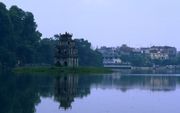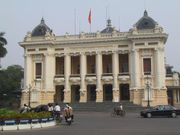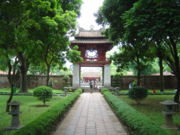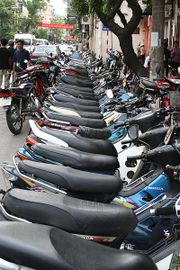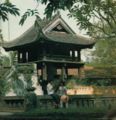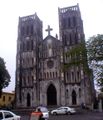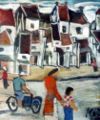Hanoi
2007 Schools Wikipedia Selection. Related subjects: Geography of Asia
Hanoi ( Vietnamese: Hà Nội) pronunciation , estimated population 3,083,800 (2004), is the capital of Vietnam. From 1010 until 1802, it was the political centre of an independent Vietnam with a few brief interruptions. It was eclipsed by Huế during the Nguyen Dynasty as the capital of Vietnam, but served as the capital of French Indochina from 1887 to 1945. From 1945 to 1976, it was the capital of North Vietnam.
The city is located on the right bank of the Red River. Hanoi is located at 21°2' North, 105°51' East (21.0333, 105.85), 1,760 km (1,094 mi) north of Ho Chi Minh City (formerly Saigon).
History
The area around modern Hanoi has been inhabited for at least 3000 years BC, one the first known permanent settlements is the Co Loa citadel at around 200 BC.
Through history, Hanoi was known by many names. During Chinese domination of Vietnam, it was known as Long Bien, Tống Bình and later Long Đỗ. In 866, it was turned into a citadel and was named Đại La.
In 1010, Lý Thái Tổ, the first ruler of the Lý Dynasty (Triều Lý), moved the capital of Đại Việt (the Great Viet, then the name of Vietnam) to the site of the Đại La Citadel. Claiming to have seen a dragon ascending the Red River, he renamed it Thăng Long (Ascending dragon)—a name still used poetically to this day. It remained the capital of Vietnam until 1397, when the capital was moved to Thanh Hóa, also known as Tây Đô (Western Capital). Thăng Long then became Đông Đô (Eastern Capital).
In 1408, Vietnam was invaded by Chinese troops from the Ming Dynasty and Đông Đô was renamed Đông Quan (Eastern Gateway) by the Chinese. In 1428, Vietnam was liberated from Chinese rule by Lê Lợi, the founder of the Le Dynasty (Triều Lê ) and Dông Quan was renamed Đông Kinh (Eastern Capital—the name known to Europeans as Tonkin; and the same characters used for Tokyo). During the Tây Son Dynasty, it was named Bắc Thành (Northern Citadel).
In 1802, when the Nguyễn Dynasty (Triều Nguyễn) was established and then moved the capital down to present-day Huế, it was renamed Thăng Long. However, the second syllable of the toponym is actually a homonym of the word long, and so, actually suggests "to flourish" as opposed to "dragon". Therefore the name would be translated roughly to to ascend and flourish. In 1831 the Nguyen Dynasty renamed it Hà Nội (which can be translated as around the bend of the river or River Interior) . Hanoi was occupied by the French in 1873 and passed to them ten years later. It became the capital of French Indochina after 1887.
The city was occupied by the Japanese in 1940, and liberated in 1945, when it became the seat of Vietnam's government. From late 1946 to early 1947, it was the scene of heavy fighting between the French and Viet Minh forces. At that point, the city became the capital of an independent North Vietnam.
During the Vietnam War Hanoi's transportation facilities were disrupted by the bombing of bridges and railways, which were, however, promptly repaired. Following the end of the war, Hanoi became the capital of all Vietnam when North and South Vietnam were reunited on July 2, 1976.
In 2004, during site surveys for construction of a new parliament house, the remnant of a massive 900 years old citadel was discovered in central Hanoi, near the site of Ba Dinh square.
Geography
Districts
Hanoi comprises of eight inner districts of Ba Đình, Cầu Giấy, Đống Đa, Hoàn Kiếm, Hai Bà Trưng, Hoàng Mai, Long Biên, Tây Hồ and Thanh Xuân, and five outer districts of Đông Anh, Gia Lâm, Từ Liêm, Thanh Trì and Sóc Sơn.
Climate
Hanoi experiences the typical climate of northern Vietnam, where summers are hot and humid, and winters are relatively cool and dry. The summer months from May to September receive the majority of rainfall in the year (1,682 mm rainfall/ year). The winter months from November to March are relatively dry, although spring then often brings light rains. The minimum winter temperature in Hanoi can dip as low as 6–7°C an get as hot as 38–40 (100-104°F). Central heating is not common in Hanoi, and wind chills may make one feel rather cold in winter.
Education
Hanoi, as the capital of Indochina, was home to the first western-style universities in Indochina, including: Hanoi Medical College (1902), Indochina University (1904), and École Supérieure des Beaux-Arts de L'Indochine (1925).
Hanoi is the largest centre of education in Vietnam. Admissions to undergraduate study are through entrance examinations, which are conducted annually and open for everyone in the country. The majority of universities in Hanoi are public, although in recent years a few private universities have started their operation.
Because most of the national universities are located in Hanoi (and Ho Chi Minh City), students from other provinces wishing to enter university often travel to Hanoi for the annual entrance examination. Such events often take place in June/July, when a large number of students and their families converge on the city for a few weeks around the examimation period. In recent years, these entrant exams have been centrally set by the ministry of education, but the passmarks are decided independently by each university.
Pre-tertiary schools in Hanoi mainly serve their local districts. Education is equivalent to the K–12 system in the US, with elementary school between grades 1 and 5, middle school (or junior high) between grades 6 and 9, and high school from grades 10 to 12.
Some pre-tertiary schools might have a few selective classes for students with higher entry scores, with a stronger emphasis on subjects such as mathematics or sciences. In addition, some schools are designated as selective where admissions are also by entrant examination on the subjects of specialization. A few major universities in Hanoi also run a limited number of high-school and middle-school classes out of their Hanoi campuses for gifted students in subjects such as mathematics, chemistry, physics, information technology, linguistics, biology, and other social science and humanity subjects.
Places of interest
As the capital of Vietnam for almost a thousand years, Hanoi is considered to be the cultural centre of Vietnam, where every dynasty has left behind their imprint. Even though some relics have not survived through wars and time, the city still has many interesting cultural and historic monuments for visitors and residents alike.
Some of the prominent places are: The Temple of Literature (Văn Miếu), site of the oldest university in Vietnam; One Pillar Pagoda (Chùa Một Cột); Flag Tower of Hanoi (Cột cờ Hà Nội); The Old Quarter and Hoàn Kiếm
Hanoi is also home to a number of museums, including the Vietnamese National History Museum, the National Museum of Ethnology, the National Museum of Fine Arts and the Revolution Museum .
The Old Quarter, near the scenic Hoan Kiem lake, has the original street layout and architecture of the old Hanoi. At the beginning of 20th century, the city consisted of only about 36 streets, most of which are now part of the old quarter. Each street then comprised of merchant and household specialized in a particular trade, such as silk traders, jewellery, etc. The street names nowadays still reflect these specializations, although few of them remain exclusively in their original commerce. The area is in general famous for its small artisans and merchants, including many silk shops. Local cuisine specialties as well as several clubs and bars can be found here also. A night market in the heart of the district opens for business every Friday, Saturday, and Sunday evening with a variety of clothing, souvenirs, and food.
West Lake (Ho>! Tay) is a popular place for people to hang out. It is the largest lake in Hanoi, and there are many temples to visit in the area. There are small boats for hire, and a floating restaurant which has been operating for a couple of decades.
Population
Hanoi's population is constantly growing, a reflection of the fact that the city is both a major metropolitan area of Northern Vietnam, and also the country's political centre. This population growth also puts a lot of pressure onto the infrastructure, some of which is antiquated and dates back from the early 20th century.
When you talk to Hanoians, they will concede that most people you meet in Hanoi these days are from somewhere else. If you define a native Hanoian as someone who has been here for three generations or more, that number is likely to be very small as compared to the overall population of the city. Even in the Old Quarter, where commerce started hundreds years ago and was mostly a family business, many of the street-front stores nowadays are owned by merchants and retailers from other provinces. The original owner family may have either rented out the store and moved to live further inside the house, or just moved out of the neighbourhood altogether. The pace of change has especially escalated after the abandonment of central-planing economic policies, and the loosening of the district-based household registrar system.
The considerate and genteel nature of Hanoians is occasionally quoted in idioms and literature, which may appear as annoyingly snobbish. In reality, they are a reflection of a past where Hanoi is the convergent point for much of the country's talents in arts and education. They are also a reflection of a system heavily entrenched in Confucian values where modesty and consideration of others were regarded with a higher priority than one's self. As the opening up of the economy has brought in other pressures on people's daily life, advocates for traditional social and family values are in many ways helping to counter an "everyone for himself" mentality.
Transportation
Hanoi is served by Noi Bai International Airport, located in the Soc Son District, approximately 40 km (25 miles) north of Hanoi. Noi Bai is the only international airport for the northern regions of Vietnam. Direct daily flights are available to other cities in Vietnam, Asia, Australia, and Europe. Flights to and from the Americas usually involve a transit. The airport has recently been rebuilt with modern facilities.
There are two main highways linking the airport and city. The route to the city via Thang Long Bridge is more direct than Highway 1, which runs along the outskirts of the city. The main highways are shared by cars, motor scooters, with separate lanes by the side for bicycles. Taxis are plentiful and usually have trip meters, although it is also common to agree on the trip price before taking a taxi from airport to the city centre. Tourists also sometimes tour the city on Cyclos especially in the Old Quarter.
Hanoi is also the origin departure point for many train routes in the country. The Union Express (tàu Thống Nhất) runs from Hanoi to Ho Chi Minh City from Hanoi station(formerly Hang Co station), with stops at cities and provinces along the line. Trains also depart Hanoi frequently for Hai Phong and other northern cities.
The main means of transport within the city are motobikes, buses, taxis, and bicycles. Motobikes remain the most common way to move around the city, due to their flexibility in navigating small streets, lack of parking spaces for cars, and also being more fuel economic than automobiles. The number of private cars are however rising every year, and traffic at peak hours can be very heavy at main intersections.
Public buses run on many routes and fare can be purchased on the bus. For short trips, "xe ôm" (literally, "hug vehicle") motorcycle taxis are available where the passenger sits at the rear of a motobike and the driver will take you to your destination. A taxi is more convenient for longer trips, and if you do not wish to travel in open air.
Economy
Though representing only 3.6 percent of the country's population and 0.3 percent of the national territory, Hanoi contributes 8 percent to the national GDP and 45 percent of the Red River Delta's economy.
Industrial production in the city has experienced a rapid boom since the 1990s, with average annual growth of 19.1 percent from 1991–95, 15.9 percent from 1996–2000, and 20.9 percent during 2001–2003. In addition to eight existing industrial parks, Hanoi is building five new large-scale industrial parks and 16 small- and medium-sized industrial clusters. The non-state economic sector is expanding fast, with more than 25,000 businesses currently operating under the Enterprise Law.
Trade is another strong sector of the city. In 2003, Hanoi had 2,000 businesses engaged in foreign trade, having established ties with 161 countries and territories. The city's export value grew by an average 11.6 percent each year from 1996–2000 and 9.1 percent during 2001–2003. The economic structure also underwent important shifts, with tourism, finance, and banking now playing an increasingly important role.
Agriculture, previously a pillar in Hanoi's economy, has striven to reform itself, introducing new high-yield plant varieties and livestock, and applying modern farming techniques.
Together with economic growth, Hanoi's appearance has also changed significantly, especially in recent years. Infrastructure is constantly being upgraded, with new roads and an improved public transportation system. The rate of telephone users was 30 per 100 people in 2003. New urban areas are growing rapidly, with 1.5 million square metres of housing constructed during 1996–2000 and 1.3 million square metres built in 2003 alone.
Social services have been developed in both scale and quality. The public healthcare network has been strengthened, ensuring at least one doctor for each commune and ward. Thanks to these accomplishments, Hanoi has the highest development index in the country. Movements such as raising donations for poor people or promoting a "cultural lifestyle", have received support from local people and been maintained.
Health care and other facilities
The following medical facilities are located in Hanoi:
- Bach Mai Hospital
- Viet Duc Hospital
- Saint Paul Hospital
- 108 Hospital
- L'Hôpital Français De Hanoï
- Hanoi Dental Clinic
- Hanoi Family Medical Practice
- International SOS Clinic
- 19-8 Hospital
Photos of Hanoi
|
Ho Chi Minh mausoleum |
|||
|
Park of Reunification (former Lenin park) |
|||

